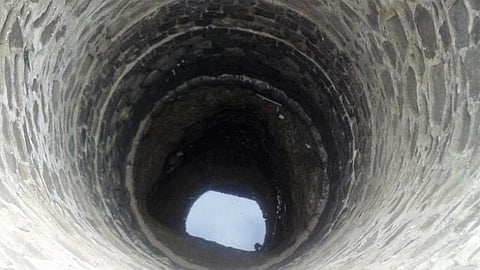
- Topics
- Feature
- Opportunities & Events
- About
- Hindi Portal
- Data
- Topics
- Feature
- Opportunities & Events
- About
- Hindi Portal
- Data

Non carcinogenic health effects of groundwater contamination are equally challenging as the carcinogenic risks. While groundwater is an important source for drinking water and irrigation in India, it is increasingly getting contaminated due to urbanisation, industrialisation and poor farming practices leading to leaching of untreated sewage, industrial effluents, fertilisers and harmful chemicals into the groundwater . Over-exploitation of groundwater has also led to rock weathering, resulting in geogenic contamination.
What do studies on fluoride and nitrate contamination of groundwater reveal? What are the risks and who are vulnerable to the health effects of this contamination?
This paper titled 'Non-carcinogenic health risk assessment of nitrate and fluoride contamination in the groundwater of Noyyal basin, India' authored by
K.P. Kom, B. Gurugnanam and S. Bairavi
from the journal Geodesy and Geodynamics informs that high amounts of nitrates and fluorides in groundwater can be extremely harmful to humans.
The most common sources from which nitrate can contaminate groundwater include septic tanks, dairy lagoons, wastewater effluents percolation, and livestock waste as well as non-point sources such as fertilisers, pesticides, and manure and can enter the food chain via groundwater and surface water. Nitrates are also released into the groundwater by natural processes through rock-water interactions. In addition, nitrate contamination of groundwater can also occur during nitrogen fixation by legume plants and microbes.
The Bureau of Indian Standards (BIS) recommends that the maximum permissible limit for nitrogen in drinking water should not be more than 45 mg/L. High levels of nitrates in the water can lead to blue infant disorder (methemoglobinemia) in infants (under 6 months of age). In adults, it increases cancer risks like stomach tumours and colorectal cancer, Hodgkin's lymphoma as well as non cancer risks such as hypertension and thyroid dysfunction. Evidence shows that over 108.2 million people in India consume water with nitrate levels exceeding the permissible limit of 100 mg/L.
Fluoride too can adversely affect human health and can occur naturally in granite terrain, get exposed in cases of over exploitation of groundwater, lead to mineral break down and release of fluoride, which can seep into the groundwater via soil moisture or rainfall infiltration.
Besides this anthropogenic sources including phosphate fertiliser plants, brick manufacturing, steel production, coal combustion, sewerage, are the major causes of high levels of fluoride in groundwater. Fluoride levels of 0.6 -1.5 mg/L in drinking water are considered safe by the World Health Organization (WHO) while fluorosis (dental and skeletal) can be caused by fluoride levels greater than 1.5 mg/L in drinking water. In addition, thyroid, arthritis, osteoporosis, infertility, and abortion have been linked to excessive fluoride intake.
Coimbatore, often referred to as the textile city of South India, is experiencing a rapid deterioration in groundwater quality due to rapid urbanisation, industrialisation, intensive agricultural and mining activities and leaching of textile effluents and sewage. However, no studies exists on the non-carcinogenic hazards posed by nitrate and fluoride contamination on human health. This study aimed at assessing the spatial distributions of nitrate and fluoride, and evaluate the non-carcinogenic health risk for infants, children, and adults in Coimbatore.
The region is bisected by the Noyyal river, flowing east-west. It is one of the most important tributaries of the Cauvery River. The upper part of the river is used for drinking and agricultural purposes, but is polluted due to untreated direct discharge of municipal sewage and effluents from the industries and textile and leather tanning industries.
Groundwater samples from different sites of the western Noyyal basin in Tamil Nadu were collected. The study found that:
Another study titled 'Non-carcinogenic health risk assessment with source identification of nitrate and fluoride polluted groundwater of Wardha sub-basin, central India' authored by
V.P. Nawale, D.B. Malpe, Deepali Marghade, Rajshree Yenkie
published in the paper Ecotoxicology and Environmental Safety collected groundwater samples during pre-monsoon from Wardha sub-basin, central India.
The study found that:
The studies recommend the need for:
Proper management and treatment of water through reverse osmosis treatment and artificial recharge
Both the papers are open access under the creative commons license (CC BY-NC-ND 4.0)